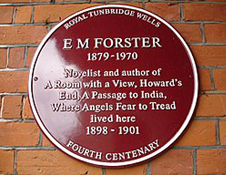 Hello there! 😀
Hello there! 😀
|
|
|
|
|
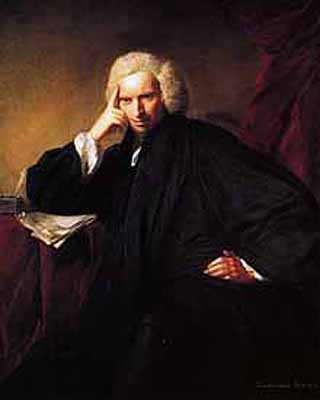
Were he alive today, Sterne would not have been surprised at the current success of fiction. His writings were intended "to teach us to love the world and our fellow creatures better than we do". Tristram Shandy is nigh-on unique in its attention-gripping mix of surreal narrative, bizarre formats, sentimentality, whimsical innuendo, opinionated dialogue and biting satire; but it opened a door to show what the novel could become (albeit that some even refuse to accept it as a novel, dubbing it "meta-fiction" or an "anti-novel").
Although Tristram Shandy is largely a self-analytical and introspective work - clearly trying out whatever outrageous stratagem would shock and intrigue its readers - its self-obsessions and experiments have implications in contexts much broader than its own pages, and indeed of its own time. Perhaps Sterne's greatest achievement in the novel was in developing a process of composition which could accommodate such a vast array of observations, ideas and universal, timeless significances from the outside world within the peculiar, claustrophobic world of Tristram's "autobiography". Sterne moved house in 1760, by which time he had already had great success with the first two volumes of Tristram Shandy. His friends celebrated his success by christening his new abode 'Shandy Hall', the word Shandy being a local dialect word for 'crack-brained' or 'odd' [1].

Diana Neill comments that 'Sterne made books as apothecaries made medicines - by pouring from one vessel to another'. [2] She draws attention to the strange make-up of his library, which, when sold in 1768, was found to contain works on topics such as, amongst others, fortifications, dioptrics, midwifery, flogging, opium and hell. He drew freely on this literary resource, on occasions even to the point of plagiarism; but he was also very much alive to aspects of, and events happening in, the non-literary world, some of which were recruited to provide material for narrative purposes, whilst others became a target for his wit and satire.
No doubt this breadth of reading and apprehension of social mores and events contributed to Sterne's awareness of the "language variants" which reside within the overall structure of a system of language. The development of the novel (in general) owes a great deal to novelists' abilities to recreate and parody the way people utilise their own variants of standard language in formal or everyday speech; and, more to the point, to the way writers use such variants in their creation of their characters. Russian literary theorist Mikhail Bakhtin classified the co-existence of such language variants within a text as "heteroglossia" and included Sterne as one of the "classic representatives" of writers of comic novels who made use of heteroglossic structures. Such authors steer a narrative course designed to throw into stark relief the inadequacies, eccentricities or superficialities of their characters as they reveal their opinions and prejudices - not just in what they say, but in the languages (plural) they each use to say it.
In his unpacking of the idea of heteroglossia, Bakhtin lists examples of such language variants as " ... the forms of parliamentary eloquence, [ ... ] the eloquence of the court, or particular forms of parliamentary protocol, or court protocol, or forms used by reporters in newspaper articles, or the dry business languages of the City, or the dealings of spectators, or the pedantic speech of scholars, or the high epic style, or Biblical style, or the style of the hypocritical moral sermon or finally the way one or another concrete and socially-determined personality, the subject of the story, happens to speak." [3] The essence of the idea is the way such languages suffuse the individual characters' personæ; and the way different characters in the same novel, using different language variants, seem more real by virtue of their co-existence within the framework of a plot, being drawn alongside each other. Thus, in the character of Tristram's father, Walter Shandy, we find someone who is obsessed with philosophical and scientific argument and who is determined always to be right, with his own individual interpretation of events. He cares little for Tristram after he has been born: "The first thing which entered my father's head [ ... ] is to sit coolly down ... and write a Tristra-paedia". All the other characters reveal their own characters via their language forms.
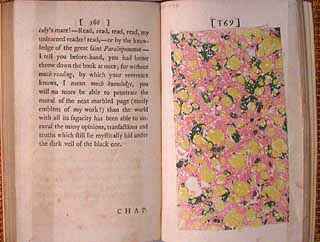
Whilst the novel was still in its infancy in the 1760s, Sterne was clearly aware that readers accustomed to linear narrative and other established conventions might well find both the style and content of the novel unusual, if not in some respects unacceptable. This didn't faze him. In fact, he was quite fearless in his utilisation of many bizarre textual and printing contrivances. This was the shock of the new writ large, with a narrative which is sometimes deliberately written in the wrong order, pages which are printed black, marbled pages, plot lines represented by a series of squiggles, weird punctuation and whole chapters apparently torn out (the page numbers in my edition jumping from 300 to 311). These are just some examples of the ways Sterne pushed back the boundaries of the nascent storytelling format.
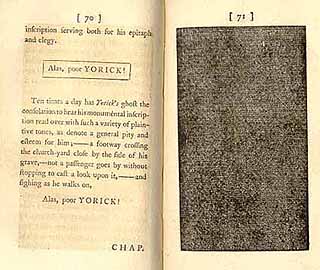
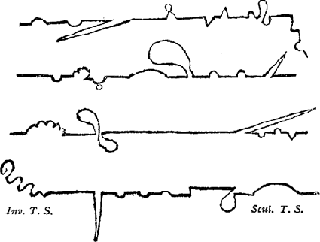
In the event, the novel did indeed provoke widespread denunciations and parodies. That Sterne knew that the book would be controversial is evident from his depiction of the circumstances of Tristram's birth, which lays the blame for his narrator's character at the door of his parents. (He isn't actually born until nearly halfway through the book). In enquiring, at the very point of his begetting, whether his father had wound up the clock, his mother had been responsible for producing Tristram's 'cast of mind', he claims; self-effacingly, he protests that, had his father not been so distracted at such an important time, he 'should have made a quite different figure in the world, from that, in which the reader is likely to see me.' Such a claim may seem only humorous from our perspective; but, as Robert Mayer [4] indicates, in the early eighteenth century there was still a commonly-held belief that the imagination could have grievous physical effects on the body. The celebrated case of Mary Toft, whose claim to have given birth to seventeen rabbits was shown to be a hoax, might have served to undermine credence in the minds of many of the gullible. But it's clear that such gullibility was a significant feature of the society of the time, as illustrated by satirical painter and social critic William Hogarth (1697-1764), who included Mary Toft and her rabbits in the painting shown below.
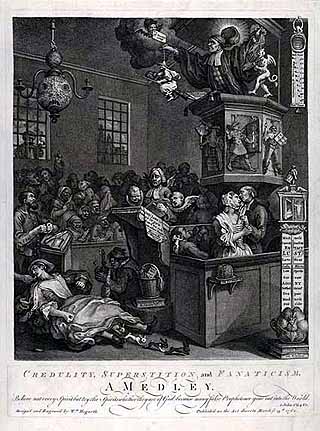
So a minority of readers might well have accepted that Tristram had been " ... precipitated into a perpetual whirl of confusion because at the moment of his conception, the imaginations of his parents were disordered."[5] (Given the timescale which measures the action of the novel, we may assume that the clock remained unwound).
The narrator frequently craves his reader's indulgence in the opening chapters. Sterne's logic is impeccable, but in letting it loose on the most recondite subject matters, he composes lines of argument, allusion and innuendo which are often no less alien, to the mind, than giving birth to rabbits would be to the body. So, in Chapter Six of Volume I, Tristram writes:
Tristram's life is writing, and his writing is his life. But in attempting to account for his personality (i.e. his life and his opinions) through a re-creation of its influences, his literary personality dissolves in the very act of self-construction. [6]
The reader's assent to Tristram's 'trifling upon the road' is thus critical to the success of the novel. Readers of epistolary novels, in which each new chapter took the form of a letter written by one of the characters, were attuned to a chronology which often stretched credibility somewhat and had been offered the unlikely opportunity to read the intimate thoughts of (sometimes all) the novels' protagonists.
... if I should seem now and then to trifle upon the road, - or should sometimes put on a fool's cap with a bell to it, for a moment or two as we pass along, - don't fly off, - but rather courteously give me credit for a little more wisdom than appears on my outside
In fact we know nothing about Tristram's 'outside'. We only know the opinions which he expresses about the world which he inhabits - yet he fails to find an organising principle, as noted by Clive T. Probyn:
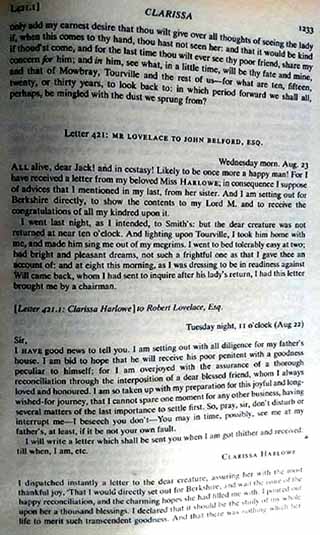
... a fertile source of obscurity it is, - and ever will be, - and that is the unsteady uses of words, which have perplexed the clearest and most exalted understandings. [7]
John Mullan highlights Sterne's use of the term 'sociality' in his last work, A Sentimental Journey, to describe an author's need to provide more than simple reportage of his character's words, if his narrator is to adequately convey sentiment and feelings to his readers, and goes on to point out that, for all his unconventionality, Sterne was also aware of general suspicions of novels' narrative form, which might be interpreted as 'suggestive, improper, promiscuous' if they were not 'thick with descriptions of how narratives should be attended to and interpreted.' [8] Rather than being a matter simply of appeals to the sympathy of the reader, the successful 'translation' of words (suggests Mullan) into sentiment and feeling required Sterne to have built a relationship of trust with the reader. He had also, claims Mullan, to incorporate not just speech but an opportunity for inference and induction', as for instance in 'the story of Le Fever' in Volume VI of Tristram Shandy, where 'the understanding of which the likes of Toby and Trim are capable [is] signified in their gestures, their sighs, their, looks'. This is certainly true, but although his characters come alive most vividly in their unbridled sentimentality, Sterne is ever the master of bathos, and one gets a distinct feeling of having been emotionally duped at the end of the Le Fever passage in Volume VI, Chapter 10:
|
Nature instantly ebbed again; - the film returned to its place, - the pulse fluttered - stopped - went on - throbbed - stopped again - moved - stopped - shall I go on? - No. |
Each person uses language to interpret the world in his or her own way. Much of the substance of the novel is taken up with the composing, or interpretation, of the world by its main protagonists, and so there are as many world pictures as there are characters. This heteroglossic frame of reference is a consequence of Sterne's reinterpretation of Locke's writings about the association of ideas. Ideas may be shared or they may be unique. But the media by which they are conveyed - words - are unstable vehicles, which cannot be relied on to deliver them intact, as Wolfgang Iser suggests:
... so each character associates something quite different with any one idea, with the result that human relations, conduct, and communication become totally unpredictable. [9] In Sterne & Irregular Oratory, Jonathan Lamb explores what he refers to as 'Sterne's largest experiment in narrative self-reference.' [10] He interprets Tristram's vastly elongated account of his own birth as a deliberate parallel with the process whereby some politicians (but William Pitt, in particular) subvert the ideals of a fair representation of the world by adopting any principle which will assist in allowing them to perform the art at which they are most accomplished: eloquence.
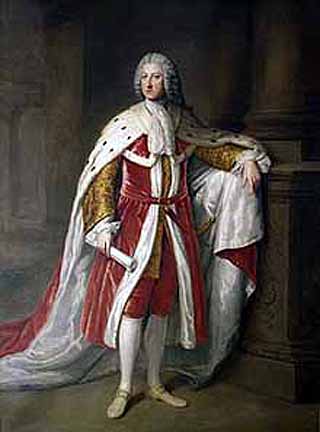
Sterne also specifically refers to the process in Volume III, Chapter Fourteen, using the metaphor of the delivery of a young child:
Whilst the novel's self-analysis can be read as a satire on the political methods of prominent politicians, it also calls into question the relationship of a politico-legal system to a governed population whose individuals lack true self-knowledge. Yorick's sermon, which takes up the lengthy Chapter Seventeen of Volume II, anatomises the body of laws by which men are governed, starting with conscience and proceeding through God's law and human law to punishment. In reality, what happens is that the 'crafty' man's conscience hides behind the law:
For the eighteenth century bourgeoisie the issue of sentiment was crucially tied to the determination of character, and that determination in turn was regarded as vital to the protection and defense [sic] of private property. [16]
Thus we see that the novel's self-analytical technique acts as a general critique of the way in which men think, communicate and govern themselves.
Laurence Sterne didn't invent the novel. But in writing Tristram Shandy he helped put the genre on a completely new track, opening it up to innumerable possibilities, giving the world insights into how people really think and communicate, warning his readers to be wary of those who would bamboozle them with the instabilities of mere words - and clearing a path for many of the most famous novelists of subsequent eras, including our own.
Notes
1. Source: The Laurence Sterne Trust
2. Diana Neill, A Short History of the English Novel, (London: Collier-Macmillan, 1964; repr. 1967), p. 84.
3. M.M. Bakhtin, from Discourse in the Novel, M. Holquist, ed. The Dialogic Imagination; included in Modern Literary Theory, ed. Philip Rice and Patricia Waugh (London and New York: Bloomsbury, Fourth ed. 2001).
4. Robert Mayer, History and the English Novel (Cambridge: CUP, 1997), p. 138.
5. Dennis Todd, Imagining Monsters: Miscreations of the Self in Eighteenth Century England (n.pl.: University of Chicago Press, 1995), p. 63, quoted in Robert Mayer, ibid. p. 138.
6. Clive T. Probyn, English Fiction of the Eighteenth Century, 1700-1789 (London: Longman, 1987) p. 140.
7. Laurence Sterne, The Life and Opinions of Tristram Shandy, Gentleman (London; n. pub, 1759-67), repr. (London: Penguin Books, 1967), p. 107.
8. John Mullan, Sentiment and Sociability: the Language of Feeling in the Eighteenth Century (Oxford: Clarendon Press, 1988; repr. 1997), p. 159.
9. Wolfgang Iser, The Act of Reading (Baltimore: The John Hopkins University Press, 1978; repr. 1980, sixth impr. 1994), p. 75.
10. Jonathan Lamb, 'Sterne and irregular oratory', in The Cambridge Companion to the Eighteenth Century Novel, ed. by John Richetti (Cambridge: CUP, 1996), p. 158
11. Lamb, ibid., p. 167.
12. TS, p. 146.
13. Judith Frank, Common Ground: Eighteenth Century English Satiric Fiction and the Poor (Stanford: Stanford University Press, 199), pp. 66-73.
14. TS, p. 146.
15. Frank, ibid., p. 70.
16. ibid., p. 70-71.
Picture credits
Laurence Sterne, painted by Joshua Reynolds (died 1792): public domain.
Marbled page from The Life and Opinions of Tristram Shandy, Gentleman First edition. Photographed by Laurence Sterne Trust staff.
Tristram Shandy plot lines: public domain.
Credulity, Superstition, and Fanaticism, A Medley; by William Hogarth, Metropolitan Museum of Art, Gift of Sarah Lazarus, 1891.
Bibliography
Allen, Walter, The English Novel (n. pl: Phoenix House, 1954; repr. Middlesex: Pelican, 1970)
Brown, Homer Obed, Institutions of the English Novel (Philadelphia: Penn, 1997)
Frank, Judith, Common Ground: Eighteenth Century English Satiric Fiction and the Poor (Stanford: Stanford University Press, 1998)
Freund, Philip, The Art of Reading The Novel (New York: Collier, 1947; repr. 1965)
Iser, Wolfgang, The Act of Reading (Baltimore: The John Hopkins University Press, 1978; repr. 1980, sixth impr. 1994)
Mayer, Robert, History and the English Novel (Cambridge: CUP, 1997)
Mullan, John, Sentiment and Sociability: the Language of Feeling in the Eighteenth Century (Oxford: Clarendon Press, 1988; repr. 1997)
Neill, Diana, A Short History of the English Novel, (London: Collier-Macmillan, 1964; repr. 1967)
Probyn, Clive T., English Fiction of the Eighteenth Century, 1700-1789 (London: Longman, 1987)
Richetti, John, ed., The Cambridge Companion to the Eighteenth Century Novel, (Cambridge: CUP, 1996)
Sterne, Laurence, The Life and Opinions of Tristram Shandy, Gentleman (London: n. pub, 1759-67), repr. (London: Penguin Books, 1967)
Watt, Ian, The Rise of the Novel (Great Britain: Chatto & Windus, 1957; repr. London: The Hogarth Press, 1987)
... when a state orator has hit the precise age to a minute, - hid his BAMBINO in his mantle so cunningly that no mortal could smell it, - and produced so critically, that no soul could say, it came in by head and shoulders, - Oh, Sirs! it has done wonders. - it has opened the sluices, and turned the brains, and shook the principles, and unhinged the politics of half a nation.
In the case of the practised orator, Sterne seems to argue, political advancement can come about as a result of the pragmatic adoption of any principle which will enhance his narration and serve his oratorical purpose. In the quotation from Tristram Shandy, this art is seen to be worn like a mantle, to disguise the politician's true nature, as 'narrative is the state orator's and the autobiographer's sleight of hand that delivers and legitimates the bambino in one recursive flourish.' [11]
When old age comes on, and repentance calls him to look back on this black account, and state it over again with his conscience, - CONSCIENCE looks into the STATUTES AT LARGE; - finds no express law broken by what he has done [...] - Conscience has got safely entrenched behind the Letter of the Law; sits there invulnerable [12]
In Common Ground [13], Judith Frank argues that Sterne was suggesting that the legal framework, which was being constantly amended and added to, was seen as a method of offering man an insight into his own conscience, his own 'composition'. On the other hand, the fact that laws were constantly having to be supplemented was evidence of their failure. So man himself should attempt to follow the 'spirit' of the law, allowing for the shortcomings of terminology. There is a political motivation here, which is specifically
... plain dealing and the safe enjoyment of our several properties, [14]
with the express implication, Frank points out, that 'what is finally at stake is the honesty of business transactions and the protection of property.' [15]
If self-analysis, the examination of the composition of one's own soul, fails to guide men along the path of righteousness, a 'benevolent' bourgeoisie, using the language of sentiment (the sermon refers to the 'helpless victim' and the 'unhappy wretch', for instance), were empowered to assist in this process by installing a legal system which made the soul visible by in?icting punishment on the body. But the deeper significance was not so much moral as economic:
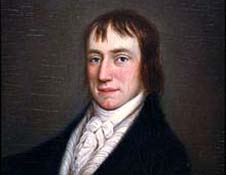
Covid-19 is forcing many people into states of isolation which they find difficult to bear. People find themselves cut off
Greetings from the Flip Flap
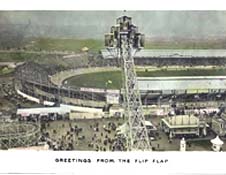
"As The Miller told his tale" ... but what was Chaucer trying to tell us?
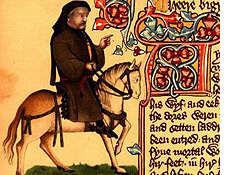
John Clare

Back to the present, as The Machine Stops
